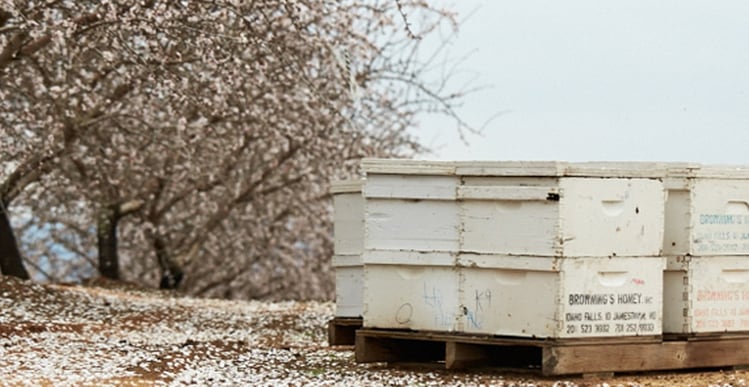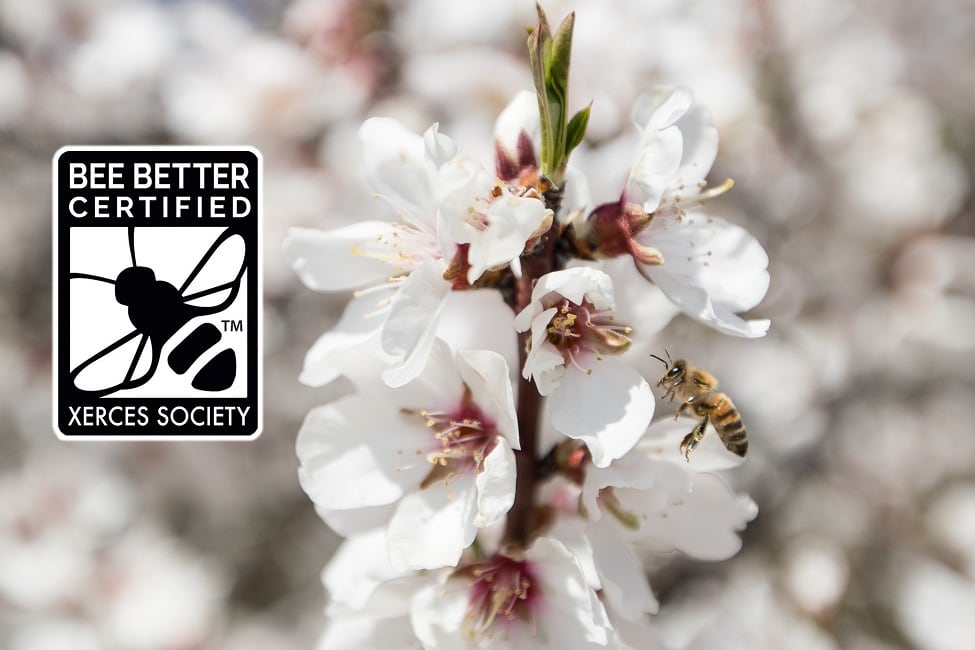The truth, as always, is more complicated, claims Dr Josette Lewis, director of agricultural affairs at the Almond Board of California, who likes to preface any conversation on this topic with the observation that almond growers are pretty motivated when it comes to ensuring honey bees are healthy and happy, given that it costs them almost $400/acre (two hives at c.$200 apiece) to hire these furry little pollinators upon which the success of their crop entirely depends.
(To put this in perspective, it cost an average of $160/acre - two hives at c. $80 apiece - in 2005.)
“Yes, there’s always room for improvement, but we’ve made great strides in making almond orchards a safe place for bees.”
USDA: Between 2007 and 2015, winter colony loss rates averaged 28.8%
As explained in a 2018 report from the USDA, the fact that honey bees are dying in record numbers in not in doubt, however: “In fall 2006 and over the ensuing winter and spring, a new health threat to honey bees emerged with a mysterious set of diagnostic symptoms in lost colonies. Entomologists soon termed this new threat colony collapse disorder. Between 2007 and 2015, winter colony loss rates averaged 28.8%, almost twice the 15% rate considered to be normal.”
That said, there appears to be "no systematic relationship between winter loss rates and subsequent annual changes in the number of managed colonies," which have remained surprisingly stable over the past 15 years, notes USDA.
So what’s going on?
The key threats to honey bee health are fairly well understood, says Dr Lewis: “Varroa mites [which weaken adult and larval bees by consuming their fat stores and spreading lethal viruses]; other pests and diseases [mites, viruses, bacteria, fungi etc]; a lack of genetic diversity among bee strains in the US and a reliance on a small pool of Queen Bees, plus there’s perhaps some inbreeding there that’s contributed to lack of vigor; lack of good forage and nutrition; and pesticide exposure.”
While almond growers are addressing the factors they can directly control (pesticide use, planting forage, wildflowers in and around orchards), they are also funding research (via ABC) into areas outside of their immediate control such as strategies for dealing with the varroa mite; bringing in ‘foreign’ bees to help US beekeepers improve breeding stock (although Russian bees “simply do not build up their numbers in time for February almond pollination” according to some reports) ; and supporting traveling bee doctors who monitor hives and advise beekeepers on pest and disease treatment, notes Dr Lewis.
“A big challenge is getting implementation of some of the tools we know improve bee health, getting bee keepers to monitor hives more regularly for varroa mites and treat them while the problem is still manageable; changing the Queen Bee breeding industry and preferences for certain kinds of Queen Bees.”
Almond pollination accounts for over 80% of the annual pollination income for beekeepers nationwide, while many beekeepers rely on almond pollination as much or more than income from honey production as well (Ferrier et al. 2018; H. Lee et al. 2017).
‘There’s always room for improvement’
As for almond growers, she says: “A good portion are doing the right thing, but there’s always room for improvement. Of the 20%+ of growers that participate in our California Almonds sustainability program, about half are implementing the practices that align with the Bee Friendly farming certification (see box) and the numbers are growing every year.”
While you can extrapolate from this that only 10% of growers therefore meet the Bee Friendly criteria, the actual number is likely higher, as many growers that don’t participate in the sustainability program are nevertheless adopting bee-friendly practices, she says.
“I would hesitate to put a number on the percentage of almond growers following Bee Friendly Farming because I suspect it is higher than 10%. We have pushed hard on our bee best management practices for the last five years, which are key elements of the BFF certification. Adding forage on top of that gets to the BFF criteria and I suspect more than 10% of farms already do cover crops or hedgerows.”
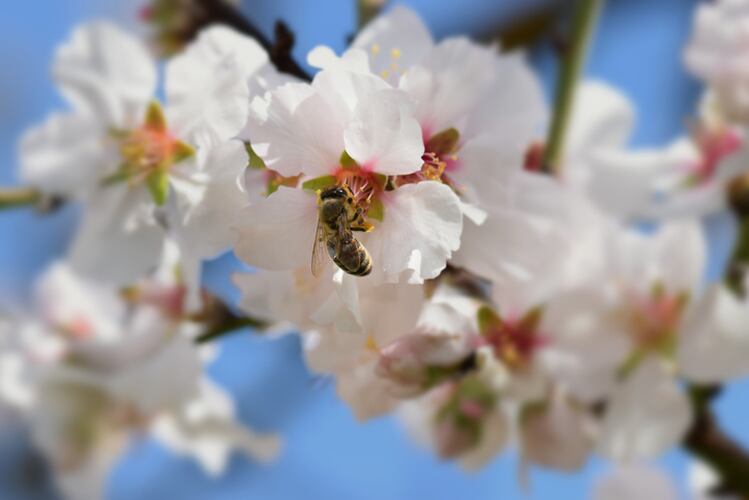
Bees spend at most two months in an almond orchard, and 10 months of the year somewhere else
However, many factors beyond the direct control of almond growers and beekeepers alike continue to present challenges, she notes.
“It’s important to remember that bees spend at most two months in an almond orchard, and 10 months of the year somewhere else, and there’s growing evidence that for many beekeepers that keep their hives say in the Midwest, that the decline in forage availability there is a major factor [in poor bee health] in addition to varroa mites and so forth.”
California almond growers also have no control over what pesticides bees are exposed to in these states, she notes, although the ABC is working with other agricultural groups to take a more holistic approach to bee health.
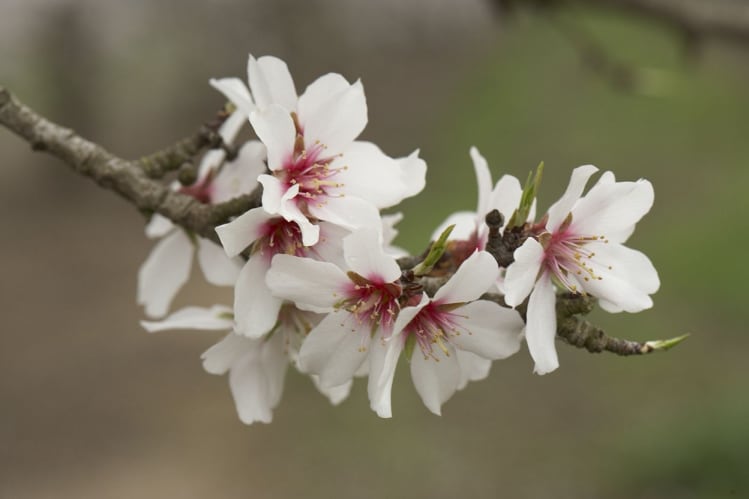
While providing additional forage for bees is something all almond growers are now actively encouraged to do, protein-packed almond pollen itself is particularly nutritious, leaving many hives stronger after they leave the orchards, says the Almond Board of California.
Cold storage and varroa mites
When it comes to varroa mites, beekeepers are deploying multiple tactics, from chemical treatments to breeding mite-resistant bees, but new research is also exploring new approaches to the problem, she says.
One new project ABC is funding along with other organizations is looking at the use of cold storage in late summer as a way to break the brood cycle in a hive – effectively tricking the bees into thinking winter is coming, so the Queen will stop laying eggs, which stops the production of brood [mites live in the brood, which are under a wax cap that treatments can’t touch], explains Dr Lewis.
“This is critical for varroa control as the varroa mite feeds off larvae in the capped brood cells. Combined with current varroa control systems this seems to be very effective. It also means that the bees slow down and the beekeeper doesn’t need to supplement their nutrition as much, which reduces costs.”
Varroa is also a significant problem in backyard hives that never travel to almonds
As for the contention that the almond orchards of the Central Valley serve as a breeding ground for disease, it is hard to deny that the rapid expansion of almond acreage over the last 20 years has “encouraged a massive co-location of otherwise geographically dispersed colonies to California’s Central Valley in the early spring, thus encouraging the spread of disease” (to quote a 2018 USDA report, which notes that commercial beekeepers now “load their honey bees on flatbeds and trek to California from as far away as Florida and North Carolina… in February for the almond bloom.”).
According to ABC data, almond ‘bearing’ acreage in California (which produces 80%+ of the world’s almonds) increased from 777,000 acres in 2010 to 1.17million acres in 2019 (+7.3% vs 2018). This year’s crop (2019/20) is looking to come in at around 2.5bn lbs (vs 2.27bn lbs in 2018/19).
However, it is “not the norm to see hundreds of thousands of hives in one location [as reported by a beekeeper quoted by The Guardian],” notes Dr Lewis, who says the California almond community has funded 125 research projects supporting bees, insights from which informed the Honey Bee Best Management Practices (BMPs) for California Almonds (launched in 2014).
“The recommendation to beekeepers is to space hives into multiple smaller groupings.”
But she adds: “Varroa is also a significant problem in backyard hives that never travel to almonds. A number of commercial beekeepers who pollinate almonds have low levels of varroa and disease due to good management.”
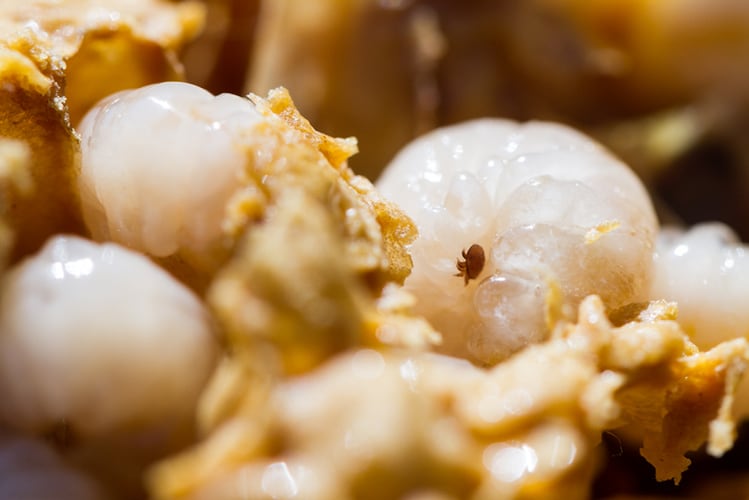
Insecticides: We’ve seen spraying decline by more than 70%
As for pesticide use, one of the key recommendations coming out of the 2014 BMPs was that growers should not have to apply any kinds of insecticides during the bloom period when the trees are still dormant and the weather is still fairly cold. “We’ve seen insecticide spraying decline by more than 70% since then,” notes Dr Lewis.
But why were growers using them in the first place if they are not needed?
In part, because they always have, and in part because they had not yet embraced integrated pest management approaches that have now become far more widespread, she says.
Fungicides: Chemicals added to fungicides (adjuvants) are perhaps more harmful to bees than originally recognized
One thing growers do still use is fungicide sprays, she says.
“The challenge is that during wet springs, fungus can develop on the bloom that can rot almonds,” but if you wait to apply fungicide until the late evening when the bees are not around, you can avoid harm to bees by significantly reducing the dosages to which they are exposed, she adds.
“Then the fungicide has had the opportunity to dry and the rate of exposure is much lower.
“We’ve also been funding research at Ohio State University that has shown that chemicals added to fungicides (adjuvants) are perhaps more harmful to bees than originally recognized, so we are starting to message to our growers to not add these products to fungicide sprays that are sometimes used when there is wet weather and tender blooms in the spring.”
Ryan Winters at Woodland, CA-based almond and walnut grower Winters Farming, told FoodNavigator-USA: “Last year it was colder and rainy and the bees spent very little time outside the hives, which was disheartening when you’re budgeting around $400/acre, so we do everything we can to attract local bees. We’re also careful to use any pesticides at night and we check the bee toxicity ratings very carefully as we’d be shooting ourselves in the foot if we used harmful ones.”
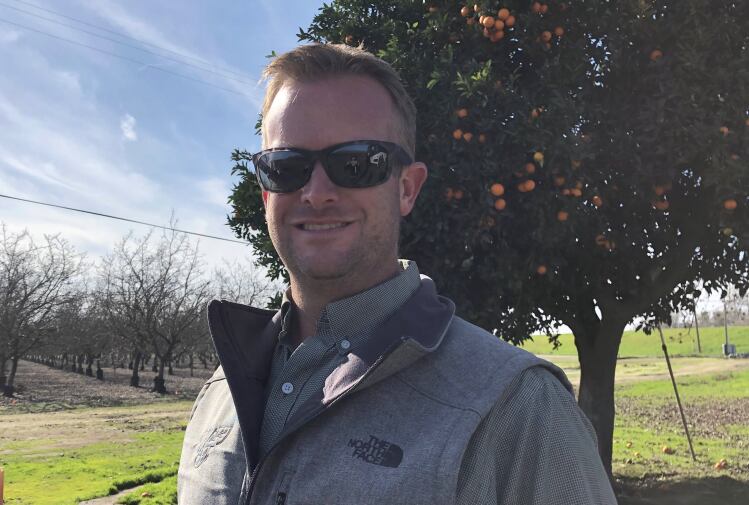
Herbicides
As for weeds between rows, growers are encouraged to allow them to grow and serve as cover crops, and supplement them with additional seeds that provide good nutrition for bees, she says.
However, weeds that grow between the trees (ie. within the same row) can be problematic as they can compete with trees for access to water and sunlight in young orchards, and disrupt micro-irrigation systems. Growers may therefore apply pre-emergent herbicides in the late winter months before the bees are present, she says.
Glyphosate is used mainly to keep weed populations down in the summer months between tree rows because the area needs to be cleared to allow almonds to be harvested (the trees are shaken, the nuts fall on the ground and lie there for a while to dry in the sun before they’re collected).
Shake and catch?
If almonds could be harvested above the floor (captured in cages as they fall from the trees, as some other crops are such as pistachios) then potentially the weeds could be left where they are, says Dr Lewis.
“We’re looking at this as it would mean we wouldn’t have to worry as much about weeds on the floors of the orchards [meaning herbicide use could be reduced].”
There is also the chance of reduced need for pesticide applications if nuts are harvested earlier, she notes, while reducing the amount of time open, mature nuts are on the tree or orchard floor reduces exposure to navel orangeworm, hull rot and aflatoxin, and tackles dust (currently almond trees are shaken, and the nuts that drop on the floor are swept into rows, left to dry and then picked off the ground, creating a lot of dust).
Ryan Winters at Winters Farming, told us that he is exploring off the ground harvesting, which could mean earlier harvesting and using a catch frame to keep nuts off the ground, but noted that equipment used for other crops harvested in this way such as pistachios or grapes would need modifications. Then decisions also need to be taken as to how and where to dry the almonds.
Neonicotinoids
As for the class of pesticide called neonicotinoids, which are often blamed for honey bees’ health problems, says Dr Lewis: “There are actually very little neonics used in almond production; there’s occasional use for some minor pests, but it’s not a major category of pesticide use in the US compared to something like row crops [such as soy and corn – which grow in areas in the Midwest where honeybees spend part of the year].”
To tackle naval orangeworms, meanwhile the ABC advocates an aggressive non-chemical integrated pest management system that starts with getting rid of ‘mummy nuts’ left on trees after harvest by shaking them again (the moths lay their eggs on the mummy nuts).
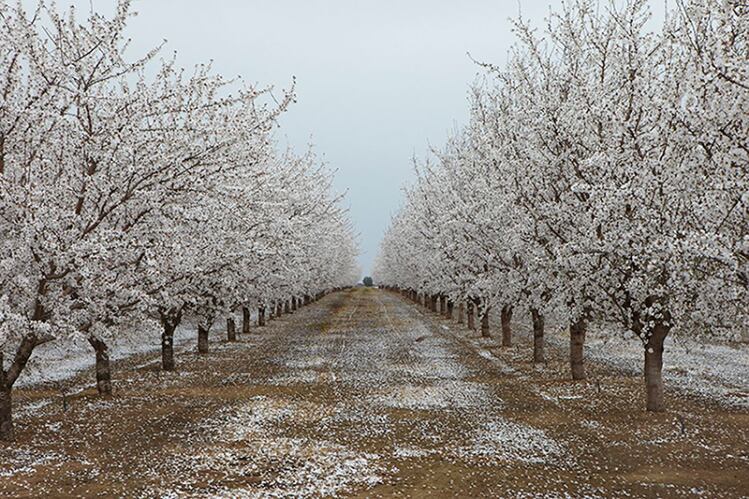
Self-pollinating almond varieties
When it comes to reducing the numbers of bees required to pollinate almond crops in the first place, several initiatives are also underway, says Dr Lewis.
One is a research project at UC Davis to look at hive stocking rates for almonds. Historically the ABC has recommended about two hives per acre, with 6-8 frames per hive, but “there’s actually not a lot of really solid science behind that,” says Dr Lewis. “We’re exploring whether we can still get high yielding almond trees with slightly fewer bees.”
More research is also going into the development of ‘self-fertile’ or ‘self-pollinating’ varieties of almonds (where only one variety needs to be planted in the orchard, as opposed to contrasting varieties planted in alternate rows).
Ryan Winters at Winters Farming, says he’s had success growing Independence varieties, although they are not a panacea.
“Independence almonds are soft shelled large kernel nuts with higher yields and a higher meat to shell ratio, but they don’t look or taste the same as Nonpareil so while you can use them in almondmilk, the main market is for inshell almonds going overseas to markets such as China and India.
“They’re not in demand for bakery and confectionery applications where people are looking for varieties such as Nonpareil. We’ve just started growing Shasta self-pollinating almonds so it will be a couple of years before we get any nuts from them, but we’ve heard they are more like Carmel almonds [which are ideal for bakery and confectionery items].”
Do self-pollinating varieties still need some bees?
While a significant percentage of new almond acres have been planted with the self-fertile Independence variety over the past five years, however, it is unlikely to replace the most popular varieties such as Nonpareil and Carmel as it has a different look and flavor, predicts Dr Lewis.
Plus, you can’t ditch bees altogether, she argues: “The Independence and the Shasta are both what we’d call self-compatible varieties that don’t have to cross-pollinate, but based on the biology of the flower and the pollination process, we believe you still need some bees [albeit not as many] so we’re funding a study this year to see how many bees are really needed for these varieties.”
“Producing only two subspecies of bees to pollinate almonds, combined with stimulating bees nearly year-round, shipping them cross country, feeding them inputs, and exposing them to agrochemicals both outside and inside the hive (miticides) has played a central role in deepening honey bee vulnerability.” Jennie Le Durant, Bitter Honey, 2019
A new Pollinator Protection Plan just unveiled by the Almond Board of California (ABC) and nonprofit Pollinator Partnership last month has five components:
1. PARTNERSHIP: The Pollinator Partnership will integrate its Bee Friendly Farming program with the bee health module in the ABC’s sustainability program to expand the number of almond farmers who provide a habitat for all pollinators on their farms.
2. EDUCATION: In partnership with universities, government agencies, beekeepers and others, ABC established the Honey Bee Best Management Practices (BMPs) in the fall of 2014. Now it is stepping up efforts to spread the word via in-orchard workshops.
3. DIGITAL MAPPING: ABC is supporting BeeWhere, a digital mapping tool that offers a real-time GIS mapping system where beekeepers can mark their hives using a mobile app. Farmers and their pest control advisers can then access information about the number and location of nearby bee hives, allowing them to adapt their practices should they need to apply a pesticide to protect the developing crop.
4. INCREASING FLORAL DIVERSITY Working with bee research organization Project Apis m. and others, ABC is encouraging farmers to plant bee pastures and hedgerows within or adjacent to orchards as additional food sources for all pollinators, including native bees.
5. SUPPORTING BEE HEALTH RESEARCH: This year, ABC is funding five new studies on how to improve honey bee health.
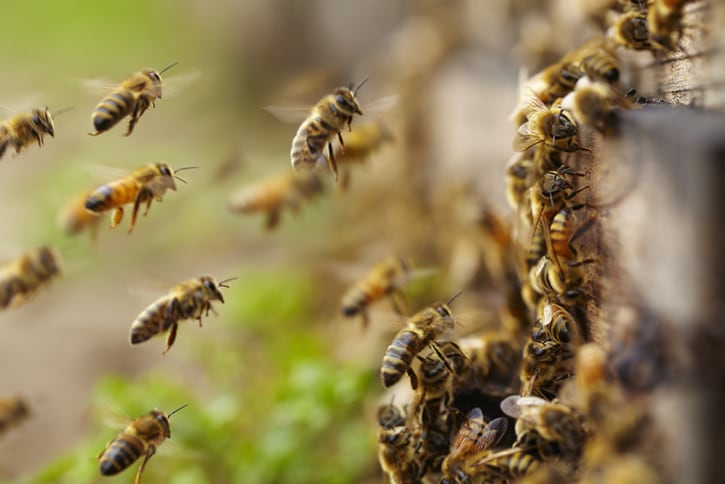
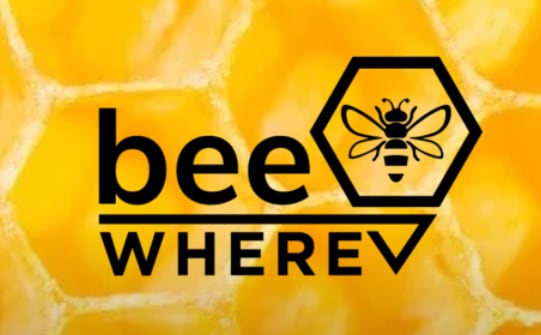
When it comes to pesticides, California almond growers must file a notice of intent for spraying bee-toxic agrochemicals with the county 48 hours in advance of the application. They then have four days to apply them or the permit expires and they must file again. In the meantime, beekeepers in the area should be notified, assuming they have registered their presence.
In interviews with Jennie Lee Durant, author of ‘Bitter Honey,’ beekeepers said they might move or place a tarp over their colonies, or more commonly, negotiate the use of a different chemical or application timing that may be less problematic for their bees.
But, she adds, this “only happens if beekeepers have registered their bees, if their colonies are visible to the grower and have contact information on them, or if they are contracted to pollinate the orchard where the agrochemicals will be applied. If they have not, then the beekeeper will not receive this call and the applicator will typically apply the chemicals without notifying those beekeepers.”
However, new initiatives such as BeeWhere, a digital mapping tool that offers a real-time GIS mapping system where beekeepers can mark their hives using a mobile app, is helping to address these issues.

